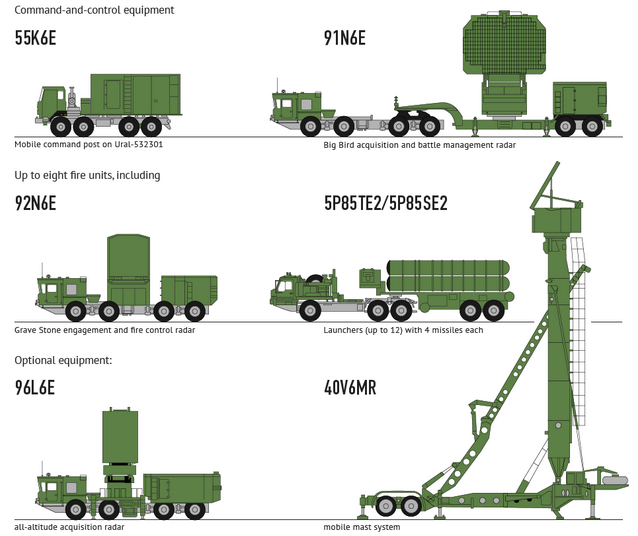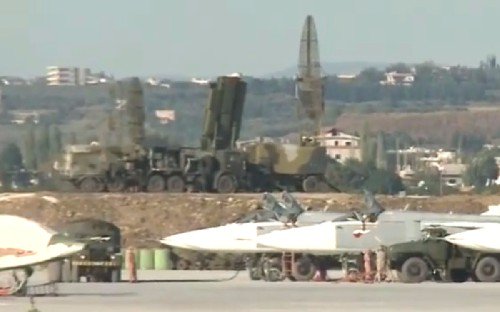Designated SA-21 “Growler” by NATO, the S-400 is believed to be able to engage all types of aerial targets including aircraft (someone says even VLO – Very Low Observable ones), drones and ballistic and cruise missiles within the range of 250 miles at an altitude of nearly 19 miles. Equipped with 3 different types of missiles and an acquisition radar capable of tracking up to 300 targets within the range of over 370 miles, the Triumph (or Triumf) is a system made of 8 launchers and a control station.
96L6 / 96L6E Radar
The Lianozovo Electromechanical Plant and the Lira KB design bureau displayed a model of their 96L6 radar vehicleSpecifications | |
| Wavelength | Centimetric |
| range, km | 300 |
| azimuth, degrees | 360 |
| elevation, degrees | -3 up to +60 |
| speed, m/s | 30-2800 |
| Targets | Up to 100 |
| update time, sec: | |
| - In the bottom zone | 6 |
| - In average and top zones | 12 |
| Setup Time from march, | 5 minutes |
Supported by effective EW (Electronic Warfare) capabilities, the S-400 fires missiles that fly at 17,000 km/h against aerial targets: at least on paper, all non-stealth planes (including 4+ Generation planes) will hardly be able to dodge them.
This means that all but U.S. F-22s and B-2s would be threatened by such an advanced air defense system over Syria (and in nearby airspaces).
The S-400 is capable of hitting targets at a height of up to 300 kilometers (186 miles). Its second distinctive feature is fire-and-forget capability. Its missiles are fitted with a homing device which can lock on a target and destroy it. Unlike US systems, it is said that the S-400 does not need to track the target. In addition, the S-400 is the only missile complex in the world capable of hitting targets located beyond the horizon. The system is also well protected against electronic warfare.
Syria Deployment
Anti-aircraft missile system S-400 "Triumph" that Russia has decided to transfer to Syria after the shoot-down of the bomber Su-24M, will not only ensure the protection of the Russian aircraft throughout the Middle Eastern country, but also can be tested in combat conditions. Such anopinion was expressed by 25 November 2015 TASS interview with military experts. After the operation in Syria S-400 will be returned to Russia.
The plans place the newest system S-400 on the Syrian Hmeymim airbase, where Russian aircraft stationed, said November 25 Russian Defense Minister Sergei Shoigu. As explained later, Assistant to the President for Military-Technical Cooperation, Vladimir Kozhin, leave the newest systems in Syria is not planned - they are transported back to Russia after the operation against terrorists.
The decision to transfer the S-400 to the Middle East was a reaction to the loss of the Su-24M, which was shot down on the eve of the Turkish F-16 fighter. Turkey said that the downed aircraft violated the airspace of the country, while the Defense Ministry insisted on the opposite - a Turkish fighter plane intruded into the sky over Syria and Russian bomber did not break any boundaries.
Related/Background:
- The Aviationist » Russia deploys S-400 and moves guided-missile cruiser off Latakia to protect its jets near Turkish border
- No US airstrikes in Syria since Russia deployed S-400 systems — RT News
- Russian S-400 in Syria: What Does it Mean for US Air Assets? — Medium
- SNAFU!: S-400 arrives at Russia's Syrian Airbase (vid)..via Alert 5.
- x




No comments:
Post a Comment